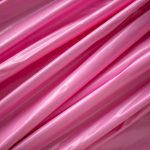I can usually tell if chiffon is silk or polyester by a few key tests. First, I touch the fabric; silk chiffon feels smooth and luxurious, while polyester is slightly rougher. Next, I do a burn test. When I burn silk, it smells like burned hair and leaves fine ash, but polyester smells chemical and melts into hard beads. Also, silk absorbs water quickly, unlike polyester. Finally, I check the price and labels, as silk is generally more expensive and labeled as '100% Silk.' These simple checks often reveal a lot about the fabric's true nature. Want to master these techniques? I can help.
Table of Contents
Key Takeaways
- Conduct a burn test: silk chiffon smells like burning hair and leaves fine ash, polyester melts and emits a chemical odor.
- Check water absorption: silk chiffon absorbs water quickly, while polyester repels it.
- Examine the fabric's feel: silk chiffon is smoother and drapes more elegantly than polyester.
- Observe light reflection and texture recovery: silk shows less wrinkling and recovers shape faster than polyester.
- Review price and labeling: silk chiffon is generally more expensive and often labeled as "100% Silk."
Understanding Fabric Weave
To identify chiffon, it's crucial to first understand how fabric weave influences its characteristics. Chiffon, known for its light, airy quality, isn't woven like other heavier fabrics. It's made using a mesh-like weave that gives it a slightly rough feel and a sheer appearance. This weave technique is what allows chiffon to drape so beautifully, making it a favorite for flowing dresses and scarves.
When I'm examining a fabric's weave, I look closely at the threads. Chiffon typically uses fine threads twisted tightly. These threads are then woven in a balanced pattern, which means the warp and weft threads are woven in a simple criss-cross pattern. This method differs from the weaves of heavier fabrics like denim or canvas, which are more tightly woven and feel sturdier.
Understanding this weave helps me distinguish between chiffon and other fabrics that might look similar but don't possess the same delicate characteristics. The key is in noticing how light plays through the fabric and how it moves in the air. Mastery of fabric identification starts with appreciating these subtle distinctions that the weave imparts.
Touch and Feel Test
I start the touch test by gently running my fingers over the fabric to feel its texture and weight. Silk chiffon usually feels smoother and has a more luxurious, supple texture compared to polyester chiffon. When I lift silk chiffon, it drapes and flows more elegantly, almost like water slipping through my fingers. In contrast, polyester chiffon is slightly stiffer and doesn't drape as softly.
Next, I check the fabric's warmth. When I press silk chiffon between my hands, it tends to warm up quickly, adapting to my body temperature. Polyester, being synthetic, feels cooler and doesn't adjust to my warmth as readily. This difference is subtle but noticeable with practice.
I also pay attention to the weight. Silk chiffon is often lighter. When I hold a similar size of polyester chiffon, it generally feels heavier. This test isn't foolproof but it gives me a good hint.
Lastly, I examine how the fabric reacts to slight tugging. Silk chiffon shows resilience, bouncing back when I stretch it gently and release. Polyester might stretch a little more and not return as smoothly to its original shape. These tactile experiences help me distinguish between silk and polyester chiffon effectively.
Burn Test Method
Moving on to the burn test method, I'll show you how to safely conduct the test and what to look for in the results.
This involves lighting a small piece of fabric and observing how it burns.
Conducting the Test
Let's start the burn test by first cutting a small sample of the chiffon fabric. I make sure it's about an inch square, enough to hold safely with tweezers. I find a well-ventilated area, preferably near a sink or with a fire extinguisher handy, just in case. I'll also need tweezers and a lighter to perform the test.
Next, I securely grip the fabric sample with the tweezers. I hold it away from anything flammable. I ignite the lighter and carefully bring the flame close to the fabric, ensuring I don't burn myself. It's crucial to observe how the fabric reacts as it comes into contact with the flame, but I'll save those details for the next step.
Analyzing Burn Results
Upon observing the fabric's reaction to the flame, I note several key outcomes. Here's a quick table comparing what happens when silk and polyester chiffon burn:
| Material | Burn Result | Odor |
|---|---|---|
| Silk | Self-extinguishes; ash | Hair-like |
| Polyester | Melts; hard bead | Sweet, chemical |
Silk chiffon stops burning as soon as it's removed from the flame, leaving behind some ash that crumbles easily. It smells a bit like burning hair, which can be quite strong. Polyester, on the other hand, melts rather than burns, creating a hard, dark bead at the end of the fiber. The smell is distinctly chemical, often described as sweet but unpleasant. Knowing these details helps you identify the material effectively.
Water Absorption Test
To test a fabric's type, I often perform a water absorption test on chiffon to see how quickly it soaks up moisture. This method is quite straightforward and can reveal whether the chiffon is silk or polyester.
Here's how I do it:
- Prepare: I cut a small square of the chiffon fabric, usually around 2×2 inches.
- Drop Water: I place the fabric flat and drop a small amount of water (about a teaspoon) right in the center.
- Observe: I watch closely to see how the fabric reacts. Silk tends to absorb water quickly, causing the spot to darken almost immediately.
- Time: I time how long it takes for the water to either spread out or disappear.
Silk chiffon absorbs water fast, showing its natural fiber qualities. Polyester, on the other hand, resists water absorption. The water often beads up on the surface, and the fabric underneath remains relatively dry and unchanged. Understanding these reactions helps me identify the material composition of chiffon accurately, ensuring that I can work with the right fabric type for my projects.
Light and Sheen Examination
Next, I'll check how chiffon reacts to light and its sheen.
I'll compare its visual texture and reflective qualities to other fabrics.
This will help me determine if I'm really looking at chiffon or something else.
Visual Texture Analysis
Examining chiffon under varying light conditions reveals its unique sheen and texture. Here's how I analyze it:
- Hold it up to natural light: Observe how the light passes through the fabric. Silk chiffon tends to have a more subtle glow compared to polyester, which often appears shinier.
- Check under artificial light: Notice how each fabric reacts differently. Silk generally displays a soft, muted sheen.
- Twist the fabric slightly: Look at how the light shifts across the material. Silk chiffon should have a graceful, fluid reflection.
- Scrunch it in your hand: Release and see the texture. Silk recovers smoothly, while polyester might show more pronounced textural changes.
This hands-on approach helps me distinguish between silk and polyester chiffon effectively.
Reflective Quality Comparison
Reflecting on chiffon's qualities, I notice significant differences in how silk and polyester manage light and sheen. Silk chiffon has a subtle, natural glow. When light hits it, the sheen is soft and diffused, almost gentle. It doesn't scream for attention but rather whispers elegance.
On the other hand, polyester chiffon can't quite capture the same effect. Its sheen is more pronounced and can sometimes appear shiny, almost plastic-like under bright lights. This difference isn't just aesthetic; it's about the quality of reflection. Silk reflects light in a way that enhances its natural grace, while polyester tends to reflect light more harshly, which can detract from its appeal.
Knowing this helps me choose the right fabric for my projects.
Wrinkle and Recovery Check
To test chiffon for wrinkles and recovery, gently scrunch the fabric in your hand and then release it. Here's what I look for to determine if the chiffon is silk or polyester:
- Immediate Appearance: Observe how the fabric looks right after I release it. Silk chiffon tends to have fewer wrinkles compared to polyester which might hold more visible creases.
- Time for Wrinkles to Disappear: I give it a few minutes. Silk generally recovers faster, smoothing out quicker than polyester. If the fabric stays wrinkly for a longer period, it's likely polyester.
- Feel of the Fabric: As I scrunch, I pay attention to the texture. Silk chiffon feels softer and more natural under my fingers, while polyester can feel slightly harsher and synthetic.
- Overall Behavior: I repeat the scrunch test a few times. Silk chiffon will consistently show quicker recovery and fewer wrinkles each time, demonstrating its resilience and high quality.
Heat Sensitivity Analysis
While conducting the heat sensitivity analysis, I'll apply a gentle heat to the chiffon to see how it reacts. This step is crucial because the response of the fabric to heat can tell us a lot about its composition. Silk, being a natural protein fiber, has a distinct behavior under heat compared to polyester, which is synthetic.
I start by holding the fabric slightly above a heat source, not directly touching it. It's key to observe carefully; silk will emit a smell similar to burning hair, as both contain proteins. In contrast, polyester melts, giving off a chemical odor. This difference helps in distinguishing between the two materials effectively.
Additionally, I carefully note the ash or residue. Silk typically leaves fine, crispy ash, while polyester forms a hard, bead-like residue when it cools down. This observation is a reliable indicator and further confirms the fabric's identity.
Through this analysis, I'm not just looking at what happens in the moment of heat application, but also the aftermath. The residue, the smell, and the change in the fabric's texture provide comprehensive clues. Mastering this technique takes practice, but it's a powerful tool in fabric identification.
Price and Labeling Differences
Examining price and labeling differences is essential for accurately identifying chiffon fabrics. When I'm out shopping for fabrics, I've learned that the feel and look can only tell me so much. It's the price and label that often reveal the true story.
Here's how I break it down:
- Price Tag: Silk chiffon generally costs more than polyester. Silk is a natural fiber and more labor-intensive to produce, which drives up its price. If I find chiffon at a surprisingly low price, it's usually polyester.
- Label Content: I always check the label for the fabric content. Labels saying '100% Silk' indicate silk chiffon, whereas labels with 'Polyester' or 'Synthetic' point to non-silk alternatives.
- Brand Reputation: High-end brands often use natural fibers, including silk. If the chiffon is from a luxury designer, there's a higher chance it's silk. Cheaper brands tend to use polyester to keep costs down.
- Care Instructions: Silk chiffon usually requires delicate handling, like dry cleaning. Polyester, on the other hand, is often machine washable. This difference in care can be a big clue.
Frequently Asked Questions
Can Allergies Be Triggered by Different Types of Chiffon?
Yes, I've found that allergies can be triggered by different types of chiffon, especially if they're treated with certain chemicals or if the fabric's natural fibers don't agree with my skin.
How Does UV Light Affect Silk and Polyester Chiffon?
UV light acts like a magnifying glass on chiffon's qualities. Silk tends to fade and weaken, while polyester shows remarkable resilience. I've noticed these effects firsthand when comparing my silk and polyester garments.
Are Silk and Polyester Chiffon Eco-Friendly Materials?
I'm exploring whether silk and polyester chiffon are eco-friendly. Silk is more natural but not always sustainably sourced. Polyester is less biodegradable but can be recycled. Both have environmental trade-offs to consider.
How Do You Store Chiffon Garments Long-Term?
To store chiffon long-term, I use acid-free tissue and a breathable garment bag. I keep it in a cool, dry place, avoiding direct sunlight to prevent fading and fabric degradation.
What Dyes Work Best for Silk Versus Polyester Chiffon?
I've found that acid dyes work best for silk chiffon, while disperse dyes are ideal for polyester. It's crucial to choose the right type for the fabric to achieve vibrant, lasting colors.
- Tetron Fabric for Marine Applications: Durability and Use Cases - June 18, 2025
- Tetron Fabric for Outdoor Furniture: Weather Resistance and Care - June 18, 2025
- Tetron Fabric for Wall Coverings: Style and Application Tips - June 18, 2025






